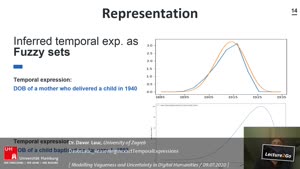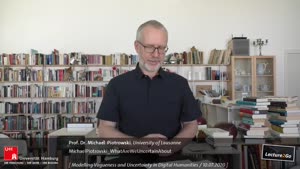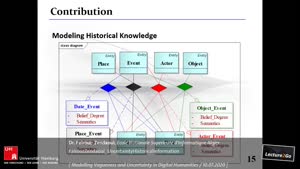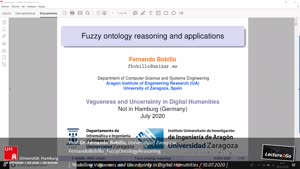FernandoBobillo_FuzzyOntologyReasoning - Prof. Dr. Fernando Bobillo - Universität Hamburg
- Lecture2Go
- Videokatalog
- F.6 - Mathematik, Informatik, Naturwissenschaften
- MIN-Fakultät
- Modelling Vagueness and Uncertainty in Digital Humanities
Videokatalog
FernandoBobillo_FuzzyOntologyReasoning
Fernnando Bobillo , University of Zaragoza, „Fuzzy ontology reasoning and applications“
Fuzzy ontologies have proved to be very useful in many application domains. One of the reasons for their success is the availability of fuzzy ontology reasoners, i.e.., software tools that are able to discover implicit knowledge that can derived from the axioms of a fuzzy ontology. In this talk, we will firstly examine the fuzzy ontology reasoner fuzzyDL and then we will overview some important examples of applications using fuzzy ontologies.
The first objective of this talk is to provide an overview of fuzzyDL, which is probably the most mature fuzzy ontology reasoner. We will discuss the fuzzy ontology elements that can be represented, as fuzzyDL supports fuzzy extensions of OWL 2 constructors and axioms, but also some traditional fuzzy logic operators, such as aggregation or defuzzification. We will also overview the supported reasoning tasks (some of them specific to the fuzzy case) and their mutual relationships. The different ways to interact with the tool will be reviewed, as different languages (a native syntax and Fuzzy OWL 2) and interfaces (terminal mode, graphical interface, and a Java API) are supported. Finally, we will provide some key implementation details (such as the underlying reasoning algorithm) and analyze some notable differences with other fuzzy ontology reasoners (paying special attention to DeLorean).
The second objective of this talk is to show some notable use cases of fuzzy ontologies in real world problems. In particular, we will focus on some recent developments where the speaker has been involved. This includes recommender systems (where the use of linguistic variables allows users to submit flexible queries), human gait recognition (where fuzzy sets make it possible to deal with the imprecision of the sensors the capture the motion), and blockchain smart contracts (where fuzzy ontologies make it possible to obtain partial agreements between two or more parts).
---
https://www.inf.uni-hamburg.de/inst/dmp/hercore/publications/vaguenessuncertainty2020.html
Digital Humanities (DH) aims not only to archive and make available materials (in particular historical artefacts) but also to introduce a better scientific reflexion into humanities by propagating computational methods. However more than ten years of consequent employment of computer-aided research did not lead to a hermeneutic-adequate digital modelling of historical objects. The main crux remains in most DH-attempts the storage of objects in database architectures designed for natural science application, the annotation with very general metadata, the mark-up with shallow linguistic information no after the language or the purpose of the document and the quantitative analysis. Not only images and texts become artificially precise, but the mutual illumination of texts and other media loses its traditional hermeneutic power.
Vagueness is one of the most important, most significant but most difficult features of historical objects, especially texts and images. Whereas ambiguity – several distinct but clear meanings- and uncertainty – conceptually clear but unknown or forgotten data - are relatively well describable phenomena, vagueness is undefined by semantics or pragmatics.
This workshop aims at bringing together for the first time experts in representation of vagueness and uncertainty and scholars from DH who went beyond state-of the art in their research and tried to apply existent theories like fuzzy logic in their work.




